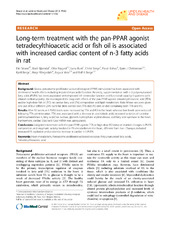| dc.contributor.author | Strand, Elin | en_US |
| dc.contributor.author | Bjørndal, Bodil | en_US |
| dc.contributor.author | Nygård, Ottar | en_US |
| dc.contributor.author | Burri, Lena | en_US |
| dc.contributor.author | Berge, Christ | en_US |
| dc.contributor.author | Bohov, Pavol | en_US |
| dc.contributor.author | Christensen, Bjørn Jostein | en_US |
| dc.contributor.author | Berge, Kjetil | en_US |
| dc.contributor.author | Wergedahl, Hege | en_US |
| dc.contributor.author | Viste, Asgaut | en_US |
| dc.contributor.author | Berge, Rolf Kristian | en_US |
| dc.date.accessioned | 2013-05-19T09:19:51Z | |
| dc.date.available | 2013-05-19T09:19:51Z | |
| dc.date.issued | 2012-06-27 | eng |
| dc.Published | Lipids in Health and Disease 2012, 11:82 | eng |
| dc.identifier.issn | 1476-511X | |
| dc.identifier.uri | https://hdl.handle.net/1956/6624 | |
| dc.description.abstract | Background: Excess peroxisome proliferator-activated receptor (PPAR) stimulation has been associated with detrimental health effects including impaired myocardial function. Recently, supplementation with n-3 polyunsaturated fatty acids (PUFA) has been associated with improved left ventricular function and functional capacity in patients with dilated cardiomyopathy. We investigated the long-term effects of the pan-PPAR agonist tetradecylthioacetic acid (TTA) and/or high-dose fish oil (FO) on cardiac fatty acid (FA) composition and lipid metabolism. Male Wistar rats were given one out of four different 25% (w/v) fat diets: control diet; TTA diet; FO diet; or diet containing both TTA and FO. Results: After 50 weeks n-3 PUFA levels were increased by TTA and FO in the heart, whereas liver levels were reduced following TTA administration. TTA was associated with a decrease in arachidonic acid, increased activities of carnitine palmitoyltransferase II, fatty acyl-CoA oxidase, glycerol-3-phosphate acyltransferase, and fatty acid synthase in the heart. Furthermore, cardiac Ucp3 and Cact mRNA was upregulated. Conclusions: Long-term treatment with the pan-PPAR agonist TTA or high-dose FO induced marked changes in PUFA composition and enzymatic activity involved in FA metabolism in the heart, different from liver. Changes included increased FA oxidation and a selective increase in cardiac n-3 PUFA. | en_US |
| dc.language.iso | eng | eng |
| dc.publisher | BioMed Central | eng |
| dc.relation.ispartof | <a href="http://hdl.handle.net/1956/7112" target="blank">Bioactive fatty acids and coronary heart disease. Mechanisms and clinical effects of dietary fatty acids</a> | eng |
| dc.rights | Attribution CC BY | eng |
| dc.rights.uri | http://creativecommons.org/licenses/by/2.0/ | eng |
| dc.subject | Heart metabolism | eng |
| dc.subject | Peroxisome proliferator-activated receptor | eng |
| dc.subject | Polyunsaturated fatty acids | eng |
| dc.subject | Tetradecylthioacetic acid | eng |
| dc.title | Long-term treatment with the pan-PPAR agonist tetradecylthioacetic acid or fish oil is associated with increased cardiac content of n-3 fatty acids in rat | en_US |
| dc.type | Peer reviewed | |
| dc.type | Journal article | |
| dc.description.version | publishedVersion | en_US |
| dc.rights.holder | Copyright 2012 Strand et al.; licensee BioMed Central Ltd. | |
| dc.identifier.doi | https://doi.org/10.1186/1476-511x-11-82 | |
| dc.identifier.cristin | 964326 | |
| dc.source.journal | Lipids in Health and Disease | |
| dc.source.40 | 11 | |

